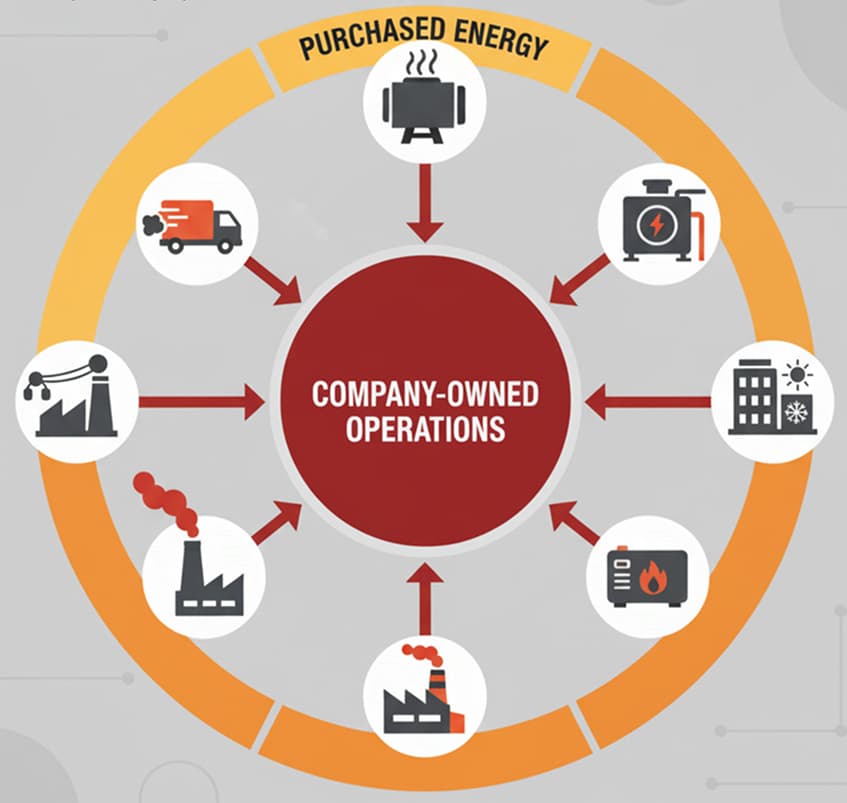Data Center Scope 2 Optimization

Powering the Digital Infrastructure Sustainably
Data centers consume approximately 1% of global electricity, a figure projected to grow as digitalization accelerates. With servers running continuously and cooling systems operating year-round, data centers face unique challenges in managing Scope 2 emissions while maintaining the reliability that modern society depends upon.
The Data Center Energy Challenge
Data centers operate under stringent reliability requirements, typically targeting 99.999% uptime. This "five nines" availability allows for only minutes of downtime annually, creating tension between sustainability goals and operational imperatives. Energy consumption in data centers breaks down into IT equipment (servers, storage, networking), cooling systems, power distribution losses, and auxiliary systems.
Power Usage Effectiveness (PUE): This key metric measures total facility energy divided by IT equipment energy. Modern efficient data centers achieve PUE values of 1.1-1.2, though the global average remains around 1.6, indicating significant improvement potential.
Strategic Approaches to Scope 2 Reduction
Location Strategy: Siting new data centers in regions with clean electricity grids and cool climates reduces both emissions and cooling requirements. Nordic countries, Pacific Northwest, and renewable-rich regions offer ideal conditions.
24/7 Renewable Matching: Leading operators are moving beyond annual renewable matching to hourly matching, ensuring renewable energy powers operations continuously. This requires sophisticated procurement strategies combining multiple renewable sources and storage.
Direct Renewable Connections: Co-locating with renewable generation or building dedicated transmission lines ensures reliable clean power. Some operators develop their own renewable projects to guarantee supply.
Cooling Innovation: Free cooling using outside air, liquid cooling for high-density deployments, and AI-optimized cooling control systems can reduce cooling energy consumption by 40% or more.
Advanced Optimization Techniques
Workload Management: Shifting computational workloads temporally and geographically to follow renewable energy availability. Cloud providers can migrate non-time-sensitive processing to locations with cleaner grids.
Energy Storage Integration: Battery systems provide backup power while enabling greater renewable integration. They can store excess renewable generation and provide grid services, improving economics.
Waste Heat Recovery: Capturing and utilizing waste heat for district heating or industrial processes transforms a liability into an asset, improving overall system efficiency.
AI-Powered Efficiency: Machine learning algorithms optimize cooling, predict equipment failures, and dynamically adjust power distribution, reducing energy waste throughout facilities.
Overcoming Data Center-Specific Barriers
Reliability Concerns: Address through redundant renewable sources, battery backup, and maintaining grid connections for emergency backup. Demonstrate that renewable-powered facilities can match or exceed traditional reliability.
Growth Management: Rapid capacity expansion can outpace renewable energy development. Plan renewable procurement in advance and consider modular approaches to match supply with demand growth.
Legacy Infrastructure: Older facilities may have limited efficiency improvement potential. Develop migration strategies to consolidate into newer, more efficient data centers.
Emerging Solutions and Technologies
Hydrogen Fuel Cells: Provide zero-emission backup power and potential primary power, replacing diesel generators while offering longer duration storage than batteries.
Liquid Immersion Cooling: Reduces cooling energy by 95% while enabling higher density computing, though requires significant infrastructure changes.
Quantum Computing: While energy-intensive initially, quantum systems could eventually provide exponential computational improvements per unit of energy.
Edge Computing: Distributing computation closer to users reduces transmission losses and enables better renewable matching through geographic diversity.
Implementation Framework
- Baseline and Benchmark: Establish current PUE and emissions baseline, benchmark against industry standards
- Efficiency First: Implement all cost-effective efficiency measures before expanding renewable procurement
- Renewable Roadmap: Develop a pathway to 100% renewable electricity with interim milestones
- Continuous Optimization: Deploy monitoring and AI systems for ongoing efficiency improvements
- Transparency and Reporting: Share progress and learnings to advance industry-wide transformation
Industry Collaboration and Standards
Data center operators are collaborating through initiatives like the Climate Neutral Data Centre Pact in Europe, committing to climate neutrality by 2030. Standards like ISO 50001 for energy management and emerging 24/7 carbon-free energy frameworks provide structure for improvement efforts.
The Business Impact
Sustainable data centers attract environmentally conscious customers, reduce long-term energy costs, and position operators as technology leaders. As regulatory pressure increases and customers demand carbon-neutral services, Scope 2 optimization becomes a competitive necessity. Leading cloud providers have shown that 100% renewable operation is achievable while maintaining world-class reliability and performance.